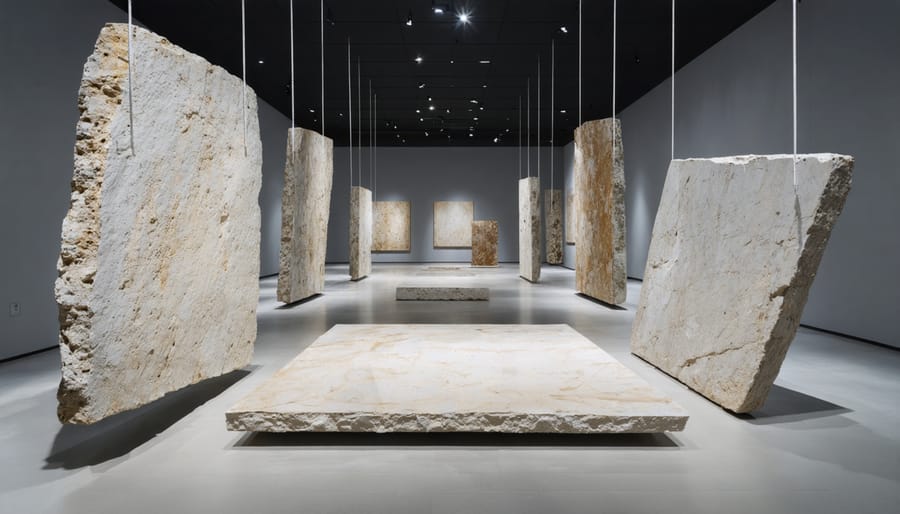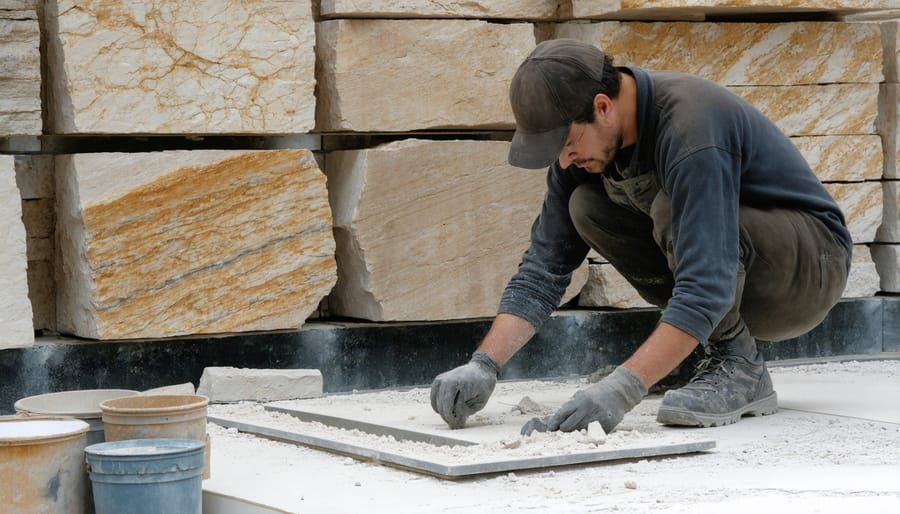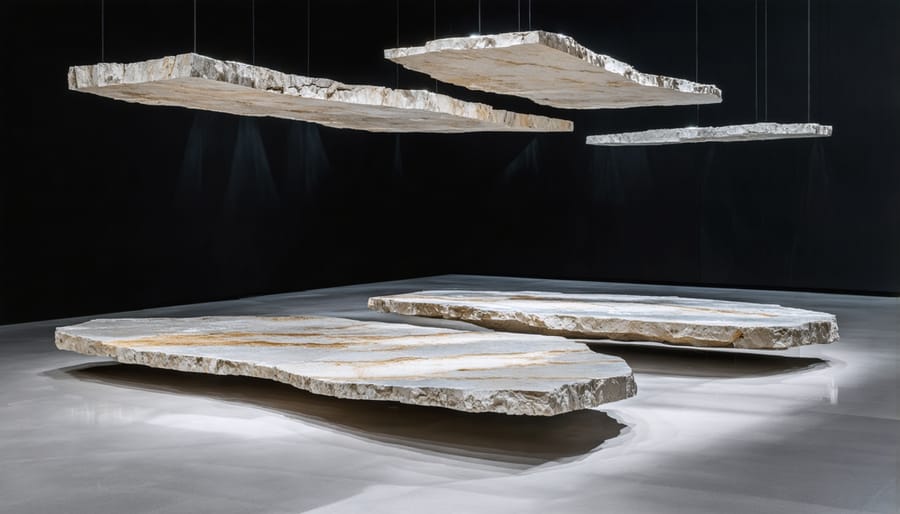Installation art transforms spaces into immersive experiences that challenge our perception of reality and redefine the relationship between artwork, environment, and viewer. Unlike traditional art forms confined to pedestals or frames, installation art commandeers entire rooms, buildings, or outdoor spaces to create multi-sensory environments that viewers don’t just observe – they inhabit. Born from the avant-garde movements of the 1960s, this revolutionary art form combines elements of sculpture, architecture, and performance to craft temporary or permanent experiences that blur the lines between art and life. Whether incorporating natural materials like stone and wood, or leveraging cutting-edge technology and light, installation artists orchestrate space, time, and materials to evoke emotional responses and spark meaningful dialogue. Through careful manipulation of scale, context, and audience interaction, installation art breaks down the traditional barriers between viewer and artwork, creating powerful experiences that resonate long after leaving the space.
What Makes Installation Art Different from Traditional Art Forms
The Role of Space and Environment
Space and environment are fundamental elements that set installation art apart from traditional art forms. Unlike paintings or sculptures that exist independently, installation artworks are intrinsically connected to their surroundings, transforming ordinary spaces into immersive experiences. Artists carefully consider the physical dimensions, lighting, acoustics, and architectural features of a space when conceptualizing their installations.
The environment becomes more than just a backdrop; it serves as an active medium that shapes how viewers interact with the artwork. Installation artists often manipulate spatial elements to guide movement, control viewpoints, and create specific emotional responses. For example, an installation might use natural stone elements to emphasize the raw, geological character of a space, or incorporate lighting techniques to cast dramatic shadows that change throughout the day.
The relationship between the artwork and its environment is so crucial that many installations cannot be meaningfully relocated without fundamentally altering their impact. This site-specific nature means that each installation becomes a unique dialogue between the artist’s vision and the physical space it occupies.

Viewer Interaction and Experience
Installation art revolutionizes the traditional viewer-artwork relationship by creating immersive environments that demand active participation rather than passive observation. Unlike conventional art forms where viewers stand at a distance, installation art invites people to step into, move through, and interact with the created space. This physical engagement transforms viewers from mere observers into integral participants of the artistic experience.
The immersive nature of installation art engages multiple senses simultaneously. Visitors might experience changes in temperature, lighting, or sound as they navigate through the space. Natural materials like stone, when used in installations, add tactile elements that viewers can touch and feel, creating a more profound connection with the artwork. The scale of installations often encompasses entire rooms or outdoor spaces, surrounding viewers completely and altering their perception of the environment.
This interactive approach allows each person to form their own unique interpretation based on their personal experience within the installation. The artwork evolves with each visitor’s presence, making every interaction distinctive and personal. This democratic approach to art appreciation breaks down traditional barriers between the artwork, the space, and the viewer, creating a more inclusive and engaging artistic experience.
Natural Stone in Installation Art

Material Properties and Artistic Expression
Installation artists harness stone’s inherent properties to create powerful artistic statements, utilizing its weight, texture, and permanence as key elements of their work. The material’s natural variations in color, pattern, and surface quality provide rich opportunities for visual and tactile exploration. Artists often juxtapose rough-hewn surfaces with polished faces to create dynamic contrasts, while the material’s mass helps ground installations both physically and conceptually.
The durability of stone allows artists to create works that withstand time and environmental factors, making it particularly suitable for outdoor installations. Its ability to be carved, split, stacked, or arranged in various configurations offers endless possibilities for spatial manipulation. Some artists emphasize stone’s relationship with light, using highly polished surfaces to reflect and redirect natural illumination, while others exploit its acoustic properties in sound-based installations.
Contemporary installation artists frequently combine stone with other materials like metal, glass, or light to create multisensory experiences. The material’s cultural and historical significance adds layers of meaning to installations, whether referencing ancient megalithic structures or modern architectural forms. Stone’s natural imperfections and geological patterns often become integral elements of the artistic narrative, telling stories of time, transformation, and environmental change through their very presence.
Sustainable and Lasting Impact
Natural stone installations stand as a testament to sustainable design principles, offering remarkable environmental benefits and unparalleled longevity. Unlike temporary art installations, sustainable stone installations can endure for generations while maintaining their aesthetic appeal and structural integrity.
The environmental impact of stone installations is notably minimal compared to other materials. Natural stone requires less processing, consumes less energy during manufacturing, and produces fewer carbon emissions throughout its lifecycle. Additionally, stone’s thermal mass properties contribute to energy efficiency in buildings, helping regulate indoor temperatures naturally.
The durability of stone installations extends their environmental benefits. With proper maintenance, stone installations can last centuries, eliminating the need for frequent replacements and reducing waste. This longevity also makes stone installations more cost-effective in the long run, despite higher initial investments.
Moreover, stone installations often appreciate in value over time, becoming historic landmarks and cultural touchstones. Many ancient stone installations continue to inspire and educate today, demonstrating the material’s ability to transcend time while maintaining its artistic and functional purpose. When eventually decommissioned, stone can be repurposed or recycled, further minimizing environmental impact and supporting circular economy principles.
Creating Your Own Stone Installation
Planning and Design Considerations
When planning a stone installation artwork, several critical factors must be carefully considered to ensure both artistic vision and practical functionality. The space’s physical characteristics, including dimensions, lighting, and traffic flow, play a crucial role in determining the installation’s scale and layout. Environmental conditions, such as temperature fluctuations and moisture levels, can significantly impact material selection and longevity.
Budget considerations, including material costs, labor, and ongoing maintenance, should be thoroughly evaluated early in the planning phase. Understanding potential installation costs helps establish realistic project parameters and ensures proper resource allocation.
Structural requirements deserve particular attention, especially for large-scale or suspended pieces. Engineers may need to verify load-bearing capacities and recommend appropriate mounting systems. The installation’s intended duration – whether temporary or permanent – influences material choices and installation methods.
Safety considerations must address both installation stability and viewer interaction. Proper lighting design not only enhances the artistic impact but also ensures safe navigation around the piece. Access points for maintenance and potential future modifications should be incorporated into the initial design.
Finally, consider the narrative context and how the installation will engage with its environment. The most successful stone installations achieve harmony between artistic expression and practical functionality while respecting the space’s existing architecture and purpose.

Technical Requirements and Implementation
Creating successful stone installations requires careful consideration of both technical and practical elements. The foundation begins with proper site assessment and preparation, ensuring the installation space can support the weight and scale of the stone elements. Structural integrity is paramount, often requiring consultation with engineers to verify load-bearing capabilities and foundation requirements.
Artists and installers must master various stone fabrication techniques to achieve their vision, including cutting, shaping, and finishing methods appropriate for different stone types. Environmental factors such as temperature fluctuations, moisture levels, and exposure to elements must be carefully evaluated to ensure the installation’s longevity.
Proper mounting systems and anchoring methods are essential for safety and stability. These may include mechanical fasteners, adhesive systems, or custom-fabricated support structures, depending on the installation’s complexity. Climate control systems might be necessary for indoor installations to maintain optimal conditions for stone preservation.
Documentation and maintenance plans should be established during the planning phase, including detailed installation procedures, material specifications, and long-term care requirements. This ensures the artwork remains structurally sound and visually impressive throughout its intended lifespan while meeting all necessary safety and building code requirements.
Installation art with natural stone represents a powerful intersection of ancient materials and contemporary artistic expression, offering unique opportunities to transform spaces and create meaningful experiences. The versatility of stone, combined with its inherent connection to nature and history, makes it an exceptional medium for installation artists seeking to create lasting impressions on viewers.
Through the strategic use of natural stone in installations, artists and designers can craft immersive environments that speak to both our primal connection to the earth and our modern aesthetic sensibilities. These installations have demonstrated the ability to transform public spaces, enhance architectural environments, and create contemplative areas that encourage interaction and reflection.
The future of installation art with natural stone appears increasingly promising as new technologies and fabrication methods expand the possibilities for creative expression. Digital design tools, advanced cutting techniques, and innovative mounting systems are enabling artists to push the boundaries of what’s possible with stone, while still honoring its natural characteristics and timeless appeal.
Looking ahead, we can expect to see more integration of sustainable practices in stone installation art, with increased emphasis on local sourcing, material efficiency, and environmental consciousness. The combination of traditional stoneworking techniques with contemporary artistic vision continues to yield installations that are not only visually striking but also environmentally responsible and culturally significant.
As our built environment evolves, installation art with natural stone remains a vital medium for creating meaningful connections between people, places, and materials. Whether in public squares, corporate spaces, or private gardens, these installations serve as powerful reminders of our relationship with the natural world while pushing the boundaries of artistic expression.










